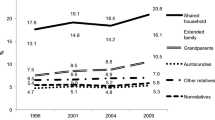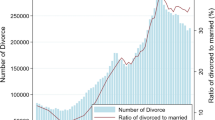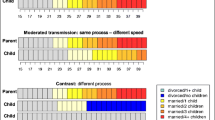Abstract
Unstable couple relationships and high rates of repartnering have increased the share of U.S. families with stepkin. Yet data on stepfamily structure are from earlier periods, include only coresident stepkin, or cover only older adults. In this study, we use new data on family structure and transfers in the Panel Study of Income Dynamics (PSID) to describe the prevalence and numbers of stepparents and stepchildren for adults of all ages and to characterize the relationship between having stepkin and transfers of time and money between generations, regardless of whether the kin live together. We find that having stepparents and stepchildren is very common among U.S. households, especially younger households. Furthermore, stepkin substantially increase the typical household’s family size; stepparents and stepchildren increase a household’s number of parents and adult children by nearly 40 % for married/cohabiting couples with living parents and children. However, having stepkin is associated with fewer transfers, particularly time transfers between married women and their stepparents and stepchildren. The increase in the number of family members due to stepkin is insufficient to compensate for the lower likelihood of transfers in stepfamilies. Our findings suggest that recent cohorts with more stepkin may give less time assistance to adult children and receive less time assistance from children in old age than prior generations.
Similar content being viewed by others
Notes
See Hoerger et al. (1997) for an economic model in which the care of elderly relatives is a function of the pooled income of its family members. In theoretical models with income pooling, larger family size increases the capacity of families to help finance the care of elderly parents. This theoretical prediction of resource pooling applies, in principle, to the time that particular family members in one generation may devote to the care of those in the other generation.
For example, in noncooperative, game-theoretic economic models of adult children’s provision of care to parents, adult children view caregiving as costly, and siblings’ caregiving substitutes for one’s own provision of care. This creates a “free-rider” problem in which the presence of one or more siblings reduces the incentive to provide care to parents (Byrne et al. 2009; Checkovich and Stern 2002; Engers and Stern 2002; Hiedemann and Stern 1999).
An exception is Lin et al. (2017), which provided a national portrait of later-life stepfamilies in the United States.
We use the term spouse/partner to refer to what PSID calls wife or “wife,” which includes legal wives and cohabiting partners of at least one year. Heads in the PSID are men except in single female–headed households and households in which the PSID sample member is a woman who has been cohabiting with her partner for less than one year.
We use the term household to refer to what PSID calls a family unit, which consists of individuals who live together and are related by blood, marriage, or adoption, or who are not related but share income and expenses.
The low bound of $100 is much more likely to capture financial transfers in poor families than the higher bound of $500 currently used by the Health and Retirement Study (HRS), thereby enhancing our ability to compare transfers across households that differ in family structure and economic resources (McGarry and Schoeni 1995).
We retain in the sample all persons who report at least one child or parent record with a valid relationship code. We eliminate households whose head or spouse has children or parents with invalid relationship codes for every such relationship. For example, a head may report two children but identify their relationship as “other,” “don’t know,” or “refuse,” rather than “biological” or “adopted.” We also eliminate households in which the heads (and spouses, if present) report that they do not know, or refuse to answer, whether their biological parents and the biological parents of their spouse, if present, are living. For all heads and spouses with a valid report of whether at least one parent is living, we assume that parents about whom they do not know or refuse to answer are not living. For example, we code heads who report that their mother is dead and they do not know whether their father is alive as having no living parents.
Attitude data suggest that respondents are more likely to report about the existence of former stepparents when relationships are closer and more enduring than when ties with former stepkin are weaker (Coleman et al. 2005; Schmeeckle et al. 2006). How to improve the quality of data on step-relationships from previous unions is an important topic for new research.
We define adult ages as 18 and older, consistent with the definition of adult offspring used in the 2013 R & T. In practice, PSID heads and their spouses are almost universally older than 18 years. In 2013, three heads and one spouse were under age 18. We include these younger heads in our sample for completeness.
We thank reviewers for the suggestion to include a control for coresidence. Controlling for coresidence accounts for any differences in how respondents report about transfers with coresident kin versus noncoresident kin. Our substantive conclusions are not affected by controlling for coresidence. The estimates in Tables 4 and 5 on transfers with parents are nearly identical with and without controls for coresidence. The estimates in Tables 6 and 7 on the association between the presence of stepchildren and the incidence of transfers with adult children are approximately 10 % smaller when we control for coresidence.
These percentage increases are high because biological children of married couples include only the biological children of both the husband and the wife, and stepchildren include the stepchild of either the head or the wife. The increases also are high because offspring from previous unions are more likely to be age 18 or older than offspring of the current union.
References
Albertini, M., & Garriga, A. (2011). The effect of divorce on parent-child contacts. European Societies, 13, 257–278.
Bumpass, L., & Lu, H.-H. (2000). Trends in cohabitation and implications for children’s family contexts in the United States. Population Studies, 54, 29–41.
Byrne, D., Goeree, M. S., Hiedemann, B., & Stern, S. (2009). Formal home health care, informal care, and family decision making. International Economic Review, 50, 1205–1242.
Case, A., & Paxson, C. (2001). Mothers and others: Who invests in children’s health? Journal of Health Economics, 20, 301–328.
Checkovick, T. J., & Stern, S. (2002). Shared caregiving responsibilities of adult siblings with elderly parents. Journal of Human Resources, 37, 441–478.
Cherlin, A. J. (2010). Demographic trends in the United States: A review of research in the 2000s. Journal of Marriage and Family, 72, 403–419.
Chesley, N., & Poppie, K. (2009). Assisting parents and in-laws: Gender, type of assistance, and couples’ employment. Journal of Marriage and Family, 71, 247–262.
Coleman, M., & Ganong, L. (2008). Normative beliefs about sharing housing with an older family member. International Journal of Aging and Human Development, 66, 49–72.
Coleman, M., Ganong, L. H., Hans, J. D., Sharp, E. A., & Rothrauff, T. C. (2005). Filial obligations in post-divorce stepfamilies. Journal of Divorce and Remarriage, 43(3–4), 1–27.
Cooney, T. M., & Uhlenberg, P. (1990). The role of divorce in men’s relations with their adult children after mid-life. Journal of Marriage and the Family, 52, 677–688.
Dalton, M., & LaFave, D. (2017). Mitigating the consequences of a health condition: The role of intra- and interhousehold assistance. Journal of Health Economics, 53, 38–52.
Eggebeen, E. J. (1992). Family structure and intergenerational exchanges. Research on Aging, 14, 427–447.
Emery, T. (2013). Intergenerational transfers and European families: Does the number of siblings matter? Demographic Research, 29(article 10), 247–274. https://doi.org/10.4054/DemRes.2013.29.10
Engers, M., & Stern, S. (2002). Long-term care and family bargaining. International Economic Review, 43, 73–114.
Furstenberg, F. F., Jr. (2014). Fifty years of family change: From consensus to complexity. Annals of the American Academy of Political and Social Science, 654, 12–30.
Ganong, L., & Coleman, M. (2006). Obligations to stepparents acquired in later life: Relationship quality and acuity of needs. Journals of Gerontology, Series B: Psychological Sciences, 61, S80–S88.
Ganong, L., & Coleman, M. (2017). Stepfamily relationships: Development, dynamics, and interventions (2nd ed.). New York, NY: Springer.
Ginther, D. K., & Pollak, R. A. (2004). Family structure and children’s educational outcomes: Blended families, stylized facts, and descriptive regressions. Demography, 41, 671–696.
Grigoryeva, A. (2017). Own gender, sibling’s gender, parent’s gender: The division of elderly parent care among adult children. American Sociological Review, 82, 116–146.
Hagestad, G. O. (1986). The family: Women and grandparents as kin-keepers. In A. Pifer & L. Bronte (Eds.), Our aging society: Paradox and promise (pp. 141–160). New York, NY: W. W. Norton.
Henretta, J. C., Hill, M. S., Li, W., Soldo, B. J., & Wolf, D. A. (1997). Selection of children to provide care: The effect of earlier parental transfers. Journals of Gerontology, Series B: Psychological Sciences, 52B(Special Issue), 110–119.
Hiedemann, B., & Stern, S. (1999). Strategic play among family members when making long-term care decisions. Journal of Economic Behavior and Organization, 40, 29–57.
Hoerger, T. J., Piccone, G. A., & Sloan, F. A. (1997). Public subsidies, private provision of care and living arrangements of the elderly. Review of Economics and Statistics, 78, 428–440.
Hogan, D. P., Eggebeen, D. J., & Clogg, C. C. (1993). The structure of intergenerational exchanges in American families. American Journal of Sociology, 98, 1428–1458.
Hurd, M., Smith, J. P., & Zissimopoulos, J. (2011). Intervivos giving over the lifecycle (RAND Working Paper Series, No. WR-524-1). Santa Monica, CA: RAND Labor and Population.
Kahn, J. R., McGill, B. S., & Bianchi, S. M. (2011). Help to family and friends: Are there gender differences at older ages? Journal of Marriage and Family, 73, 77–92.
Kalmijn, M. (2007). Gender differences in the effects of divorce, widowhood and remarriage on intergenerational support: Does marriage protect fathers? Social Forces, 85, 1079–1104.
Kalmijn, M. (2013). Adult children’s relationships with married parents, divorced parents, and stepparents: Biology, marriage, or residence? Journal of Marriage and Family, 75, 1181–1193.
Kalmijn, M. (2015). Relationships between fathers and adult children: The cumulative effects of divorce and repartnering. Journal of Family Issues, 36, 737–759.
Kreider, R. M. (2008). Improvements to demographic household data in the Current Population Survey: 2007 (Housing and Household Economic Statistics Division working paper). Washington, DC: U.S. Census Bureau.
Lin, I.-F., Brown, S. L., & Cupka, C. J. (2017). A national portrait of stepfamilies in later life. Journals of Gerontology, Series B: Psychological Sciences, 73, 1043–1054.
Luo, Y., LaPierre, T. A., Hughes, M. E., & Waite, L. J. (2012). Grandparents providing care to grandchildren: A population-based study of continuity and change. Journal of Family Issues, 33, 1143–1167.
Manning, W. D., Brown, S. L., & Stykes, J. B. (2014). Family complexity among children in the United States. Annals of the American Academy of Political & Social Science, 654, 48–65.
McGarry, K. (1998). Caring for the elderly: The role of adult children. In D. A. Wise (Ed.), Inquiries in the economics of aging (pp. 133–163). Chicago, IL: University of Chicago Press.
McGarry, K. (2016). Dynamic aspects of family transfers. Journal of Public Economics, 137, 1–13.
McGarry, K., & Schoeni, R. F. (1995). Transfer behavior in the Health and Retirement Study: Measurement and the redistribution of resources within the family. Journal of Human Resources, 30, S184–S226.
Parker, K. (2011). A portrait of stepfamilies (Social and Demographic Trends report). Washington, DC: Pew Research Center. Retrieved from http://www.pewsocialtrends.org/2011/01/13/a-portrait-of-stepfamilies
Pezzin, L. E., Pollak, R. A., & Schone, B. S. (2008). Parental marital disruption, family type, and transfers to disabled elderly parents. Journals of Gerontology, Series B: Psychological Sciences, 63, S349–S358.
Pezzin, L. E., & Schone, B. S. (1999). Parental marital disruption and intergenerational transfers: An analysis of lone elderly parents and their children. Demography, 36, 287–297.
Pillemer, K., & Suitor, J. J. (2006). Making choices: A within-family study of caregiver selection. Gerontologist, 46, 439–448.
Schmeeckle, M., Giarrusso, R., Feng, D., & Bengtson, V. L. (2006). What makes someone family? Adult children’s perceptions of current and former stepparents. Journal of Marriage and Family, 68, 595–610.
Schoeni, R. F., Bianchi, S. M., Hotz, V. J., Seltzer, J. A., & Wiemers, E. E. (2015). Intergenerational transfers and rosters of the extended family: A new substudy of the Panel Study of Income Dynamics. Longitudinal and Life Course Studies, 6, 319–330.
Seltzer, J. A., & Bianchi, S. M. (2013). Demographic change and parent-child relationships in adulthood. Annual Review of Sociology, 39, 275–290.
Seltzer, J. A., Lau, C. Q., & Bianchi, S. M. (2012). Doubling up when times are tough: A study of obligations to share a home in response to economic hardship. Social Science Research, 41, 1307–1319.
Seltzer, J. A., Yahirun, J. J., & Bianchi, S. M. (2013). Coresidence and geographic proximity of mothers and adult children in stepfamilies. Journal of Marriage and Family, 75, 1164–1180.
Uhlenberg, P., & Hammill, B. G. (1998). Frequency of grandparent contact with grandchild sets: Six factors that make a difference. Gerontologist, 38, 276–285.
van Gaalen, R. I., & Dykstra, P. A. (2006). Solidarity and conflict between adult children and parents: A latent class analysis. Journal of Marriage and Family, 68, 947–960.
Wachter, K. W. (1997). Kinship resources for the elderly. Philosophical Transactions of the Royal Society B: Biological Sciences, 352, 1811–1817.
Ward, R. A., Spitze, G., & Deane, G. (2009). The more the merrier? Multiple parent-adult child relations. Journal of Marriage and Family, 71, 161–173.
White, L. (1992). The effect of parental divorce and remarriage on parental support for adult children. Journal of Family Issues, 13, 234–250.
White, L. (1994). Stepfamilies over the life course: Social support. In A. Booth & J. Dunn (Eds.), Stepfamilies: Who benefits? Who does not? (pp. 109–137). Hillsdale, NJ: Erlbaum.
Wolf, D. A., & Soldo, B. J. (1988). Household composition choices of older unmarried women. Demography, 25, 387–403.
Yahirun, J. J., Park, S. S., & Seltzer, J. A. (2018). Step-grandparenthood in the United States. Journals of Gerontology, Series B: Psychological Sciences, 73, 1055–1065.
Acknowledgments
This article was presented at the 2015 annual meeting of the Population Association of America in San Diego, CA. We thank Shelly Lundberg for comments on that earlier draft. The data from the 2013 PSID Rosters and Transfers Module used in this article, as well as the analyses presented, were funded by NIA Grant P01 AG029409, and the construction of the weights was supported by the Alfred P. Sloan Foundation (Grant No. 2011-6-24). The project was also supported in part by the California Center for Population Research at UCLA (CCPR), which receives core support (P2C-HD041022) from the Eunice Kennedy Shriver National Institute of Child Health and Human Development (NICHD), and by the Duke Population Research Institute (DuPRI), which receives core support (P30AG034424) from the National Institute on Aging. We thank Sung Park and Joshua Rasmussen for their research assistance in preparing this article. Sadly, Suzanne Bianchi passed away before this article was published, but the article could not have been written without her contributions.
Author information
Authors and Affiliations
Corresponding author
Additional information
Suzanne M. Bianchi died before publication of this work was completed.
Electronic supplementary material
ESM 1
(PDF 238 kb)
Rights and permissions
About this article
Cite this article
Wiemers, E.E., Seltzer, J.A., Schoeni, R.F. et al. Stepfamily Structure and Transfers Between Generations in U.S. Families. Demography 56, 229–260 (2019). https://doi.org/10.1007/s13524-018-0740-1
Published:
Issue Date:
DOI: https://doi.org/10.1007/s13524-018-0740-1




